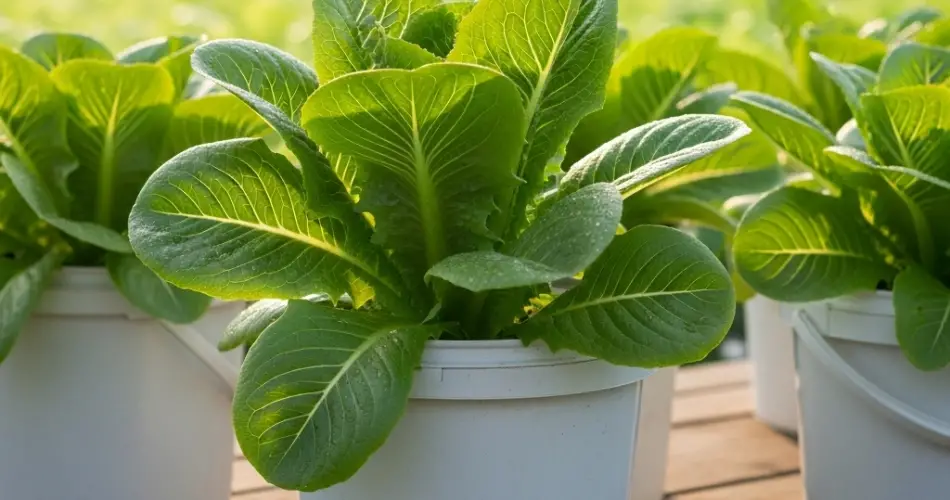Lettuce is one of the easiest and most rewarding vegetables to grow at home. With its fast growth, crisp leaves, and countless culinary uses, lettuce is perfect for both new and experienced gardeners. Even if you don’t have a backyard or much space, you can still enjoy fresh harvests by growing lettuce in simple containers. One of the most practical options is bucket gardening. Affordable, portable, and space-saving, buckets provide everything you need to cultivate lush, healthy lettuce right on your balcony, patio, or windowsill.
Why Choose Buckets for Lettuce?
Buckets make excellent containers for lettuce because they are widely available, inexpensive, and easy to repurpose. Unlike shallow trays, buckets offer enough depth for soil, ensuring better root growth and moisture retention. Their portability allows you to move them to catch more sun or shift them into shade on very hot days. With the right setup, bucket gardening eliminates the need for large garden plots and makes fresh, homegrown greens accessible to anyone, even in urban environments.
Choosing the Right Bucket
Start with a clean, food-safe bucket that holds at least 3 to 5 gallons. Plastic buckets are lightweight and affordable, while metal ones provide durability and a rustic look. Whichever you choose, ensure proper drainage by drilling several holes in the bottom. Without good drainage, water will collect in the soil, leading to root rot and poor plant health.
Adding a layer of small stones or broken pottery at the bottom can improve drainage further. Line the bucket with landscape fabric or mesh to keep soil in place while still letting water flow out.
Soil Preparation
Lettuce grows best in light, nutrient-rich soil that drains well yet holds enough moisture for consistent hydration. A mix of potting soil, compost, and perlite works well. The compost enriches the soil with nutrients, while perlite improves aeration and prevents compaction. Aim for a soil pH between 6.0 and 7.0, which is slightly acidic to neutral, for optimal growth.
Because lettuce has shallow roots, the top 6 to 8 inches of soil is where most of the action happens. Focus on keeping this layer fertile and evenly moist to support healthy leaves.
Planting Lettuce in Buckets
You can grow lettuce either from seeds or seedlings. If using seeds, scatter them evenly on the surface and cover lightly with soil—just about a quarter of an inch. Lettuce seeds need light to germinate, so avoid burying them too deep. Keep the soil consistently moist until the seedlings emerge, usually within 7 to 10 days.
For seedlings, space them about 6 inches apart to allow each plant enough room to spread. Depending on the bucket size, you can fit several plants in one container, creating a mini salad garden.
Sunlight and Placement
Lettuce prefers cool weather and partial sunlight. Place your bucket in a spot that receives 4 to 6 hours of sunlight daily. Too much heat can cause lettuce to bolt, producing flowers and seeds instead of tender leaves. If you live in a warm climate, position the bucket where it gets morning sun and afternoon shade. During hot summer days, moving the bucket to a shaded area helps extend your growing season.
Watering and Fertilizing
Consistent moisture is key to growing crisp lettuce. Since buckets dry out faster than garden soil, check the moisture daily. Water when the top inch of soil feels dry, keeping it evenly moist but not waterlogged. Mulching with straw, shredded leaves, or grass clippings can help retain moisture and regulate soil temperature.
Fertilize lettuce every 2 to 3 weeks with a balanced liquid fertilizer or compost tea. Lettuce is a light feeder compared to other vegetables, but regular small boosts of nutrients encourage steady leaf production. Avoid over-fertilizing, as this can lead to bitter-tasting leaves.
Harvesting Your Lettuce
One of the best things about growing lettuce is its quick turnaround. Depending on the variety, you can begin harvesting baby leaves in as little as 30 days, while full heads are usually ready in 45 to 60 days.
There are two main harvesting methods:
-
Cut-and-come-again – Snip the outer leaves while allowing the center to keep growing. This method provides continuous harvests for several weeks.
-
Full head harvest – Pull up the entire plant or cut it at the base when it reaches maturity. This is ideal if you want whole heads of lettuce for meals.
Frequent harvesting not only gives you fresh greens but also encourages the plant to produce more leaves.
Pest and Care Tips
Common pests like aphids, slugs, and snails can target lettuce. Inspect your plants regularly and remove pests by hand or use natural methods such as neem oil or diatomaceous earth. Because lettuce grows quickly, it often stays ahead of serious pest problems, especially in container gardens where conditions are easier to control.
Rotate buckets between crops if possible. After harvesting lettuce, you can reuse the same bucket to grow herbs, radishes, or other quick-growing vegetables. This prevents soil exhaustion and keeps your container garden productive year-round.
Final Thoughts
Bucket gardening makes lettuce growing simple, affordable, and highly rewarding for beginners. With just a few supplies, you can enjoy a steady supply of crisp, homegrown greens right outside your door. By paying attention to soil, sunlight, and consistent watering, even novice gardeners can achieve abundant harvests. Whether you prefer baby greens for salads or full heads for wraps and sandwiches, growing lettuce in buckets offers freshness, convenience, and the satisfaction of eating what you grow.



